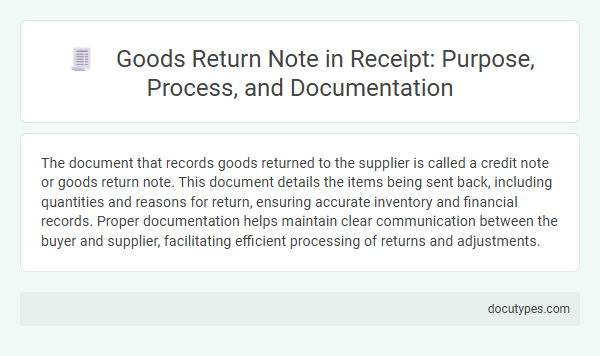The document that records goods returned to the supplier is called a credit note or goods return note. This document details the items being sent back, including quantities and reasons for return, ensuring accurate inventory and financial records. Proper documentation helps maintain clear communication between the buyer and supplier, facilitating efficient processing of returns and adjustments.
Understanding Goods Return Notes in Receipts
Goods returned to a supplier are documented through specific records that track the return process and ensure accurate inventory and financial management. Understanding Goods Return Notes is essential for proper receipt documentation and supplier communication.
- Goods Return Note - A formal document issued to record the details of goods sent back to the supplier.
- Purpose - It helps in adjusting inventory levels and processing supplier credits or refunds accurately.
- Content - Typically includes product description, quantity returned, reason for return, and supplier information.
Goods Return Notes play a critical role in maintaining transparent and efficient receipt records for returned goods.
Purpose of a Goods Return Note
| Document Name | Goods Return Note |
|---|---|
| Purpose | The Goods Return Note serves as a formal record of items sent back to a supplier due to defects, incorrect shipments, or surplus stock. It documents the details of goods returned, including quantities, descriptions, and reasons for return. |
| Importance | This document ensures accurate inventory management and provides proof for supplier claims and credit requests. Your business can track returned merchandise efficiently, minimizing discrepancies in stock records. |
| Key Details Included | Supplier information, return date, product details, reason for return, and authorization signatures. |
| Usage | Used in accounting and inventory control to verify returned goods and update records accordingly. |
Key Components of a Goods Return Note
A Goods Return Note is the document that records goods returned to a supplier. Key components include the supplier's details, the description and quantity of returned items, and the reason for the return. You must ensure the note clearly reflects these elements to maintain accurate inventory and financial records.
When to Issue a Goods Return Note
A Goods Return Note is the official document used to record goods returned to a supplier. Issuing this note ensures accurate tracking of inventory and financial adjustments.
- Goods Return Note Purpose - This document formally acknowledges the return of defective, excess, or incorrect items to the supplier.
- Timing of Issuance - The Goods Return Note should be issued immediately upon deciding to return goods to maintain proper records.
- Impact on Inventory - Issuing the note helps update stock levels and initiates necessary credit or refund processing with the supplier.
The Standard Process for Returning Goods
Which document records goods returned to the supplier? The Return Merchandise Authorization (RMA) form is the primary document used to record goods returned to the supplier. This document ensures accurate tracking and communication throughout the standard process for returning goods.
Essential Documentation for Goods Returns
The document that records goods returned to a supplier is known as the Goods Return Note or Return Merchandise Authorization (RMA). This essential documentation ensures accurate tracking and accountability of returned items in your supply chain.
It serves as proof of the return transaction between the buyer and supplier, detailing quantities, reasons for return, and conditions of goods.
- Goods Return Note (GRN) - This document specifies the items being returned, including descriptions and quantities, providing a formal record for both parties.
- Return Merchandise Authorization (RMA) - An approval document issued by the supplier that authorizes the return and facilitates processing.
- Credit Note - Issued after returns are accepted, this document reflects the monetary value credited back to the buyer's account for returned goods.
Legal Requirements for Goods Return Notes
A Goods Return Note is the official document that records goods returned to a supplier. It serves as proof of the return transaction and details the items being sent back.
Legal requirements for Goods Return Notes include accurate item descriptions, quantities, return reasons, and dates. Your business must maintain these records to comply with tax regulations and facilitate dispute resolution.
Role of Receipts in Goods Return Transactions
The document that records goods returned to a supplier is called a Return Merchandise Authorization (RMA) or Goods Return Note. Receipts play a crucial role in goods return transactions by serving as proof of the returned items and ensuring accurate inventory and financial records. Proper documentation helps facilitate supplier credit, refunds, or replacement of goods, maintaining transparency in the supply chain process.
Common Errors in Goods Return Documentation
The document that records goods returned to the supplier is typically called a Goods Return Note or Return Delivery Note. It serves as proof of the returned items and helps maintain accurate inventory records.
Common errors in goods return documentation include incorrect item descriptions and mismatched quantities, leading to disputes or delays in processing. You must ensure all details are accurately recorded to prevent issues with supplier claims or inventory tracking.
Which Document Records Goods Returned to Supplier? Infographic

